:max_bytes(150000):strip_icc():format(webp)/GettyImages-527803604-ad6f389c89ff4be1b953a3c2cdc64c09.jpg)
2 Effective Ways to Make SRT File Translation Like a Pro

2 Effective Ways to Make SRT File Translation Like a Pro
Whether you download YouTube SRT in Spanish or want to add translated subtitles to your favorite cartoon video, having an SRT translator will come in handy. The SRT subtitle file is based on texts divided into multiple sections. When you add it to a video, the texts will be displayed as you wrote in the file.
As most people find the translation work tedious, we have presented the two easiest ways of SRT file translation so without anyone’s assistance or prior training.
- Method 2 Translate subtitle .srt file without Downloading Any Software
- [Optional] If you hope to Edit SRT file for Video, here is the Best Way
Method 1 Translate SRT subtitles with third-party translator software
As there are so many different translator software platforms you can try to convert the SRT file to another language, you may be unable to choose the right one. That’s why we have explained the proper process for better clarification.
1. Redokun
One of the best software platforms you can use to translate the SRT file into another language is Redokun. It comes with a machine-automated translation that will automatically translate one language to another within minutes, increasing the overall productivity by 60%. It accurately processes the translation and ensures the texts don’t change during translation. Besides, this SRT file translator comes with a Translator Memory to help you quickly check past files.

Pros
- Easy to use software
- Supports smart revisions for last-minute alterations
- Precise and accurate translator
Cons
- Supports only 14 days of trial
How to translate SRT files?
- Visit Redokun and open the translator.
- Upload the SRT file from local or cloud storage and wait for the document to get uploaded.
- Set the input and output languages and click on the Translate button.
- The new SRT file will get generated with translated text.
Supported OS: Mac and Windows
Supported language translation: English, German, Chinese, and so on.
2. Smartcat
Another outstanding online tool you can use is Smartcat. It supports eight different translator engines, including Amazon and Google. It also accepts multiple file formats and supports over 240 languages, ensuring the SRT file can be translated within minutes.

Pros
- Does not require any expert knowledge
- Translates through AI program for more accuracy
- Support extracting the text from .xml
Cons
- Might not be suitable for beginners
How to translate SRT files?
- Log in to Smartcat and click on Upload. Choose the SRT file and click on Open.
- As the document downloads on the translator, set its language if the default language is not the same. Also, set the new language in which you want the translation.
- Click on Translate and wait for a couple of minutes.
- After a certain time, the new file will be generated with texts written in the language you have set.
Supported OS: Windows and Mac
Supported language translation: English, Mexican, Spanish, Brazilian, and more
3. SDL Trados Studio
SDL Trados Studio is a perfect tool for SRT file translation into another language in no time. It features an AI-powered algorithm that ensures the maximum accuracy in the translated file.

Pros
- Supports multiple languages for translation
- Has free plans
- Accurate translation with no error
Cons
- Not suitable for pros
How to translate SRT files?
- Upload the SRT file on SDL Trados Studio and select the original language from the dropdown.
- Open the language dropdown from the output window and choose the desired language.
- Click on Translate and wait for the new file to be generated.
Supported OS: Mac and Windows
Supported language translation: English, Japanese, Spanish, French, and Italian
4. MemoQ Translator Pro
Based on a computer-based program, this translator software makes the work easier, ensuring easy usage without any hurdles. You won’t have to worry about the texts changing their meaning or getting corrupted during translation.

Pros
- Remembers the past translations
- Increases productivity with faster translation
- Open-source platform
Cons
- Not ideal for beginners
How to translate SRT files?
- Once you upload the file to the software, the texts will be displayed on one side. Choose the language in which you want the final file and click on Translate.
- Each text block will be translated at a time. Once it is over, a green mark will be shown on the side.
Supported OS: Windows
Supported language translation: English, French, Italian, Greek, and Hindi
5. Lokalise
Used even by professional companies, this excellent online tool SRT translator is perfect for Windows and Mac and allows hassle-free translation. It comes with an intuitive UI, ensuring beginners can also efficiently work on the SRT file translation.

Pros
- Easy user interface
- Supports multiple languages
- Allows export of the translated file
Cons
- Does not allow editing of the SRT file
How to translate SRT files?
- Choose the languages for both sides from the dropdown and then upload the concerned SRT file.
- Click on the Translate button and wait for the new file to be generated.
- Once the translation is completed, it will generate the file, and you can download it.
Supported OS: Windows and Mac
Supported language translation: French, Italian, Korean, Spanish, Chinese, etc.
6. Text United
This online platform allows you to translate and upload SRT files easily. It ensures maximum accuracy and does not introduce any error in the translated file.

Pros
- Interface is easy-to-use with clear translating process
- Faster translation for more productivity
- Free software
Cons
- Not an open-source platform
How to translate SRT files?
- Upload the original SRT file and select the input language.
- Once done, select the output language and click on Translate.
- The new subtitles will be generated in the new language after a couple of minutes.
Supported OS: Mac and Windows
Supported language translation: English, German, French
Method 2 Translate subtitle .srt file without Downloading Any Software
The other method for translating the SRT files from one language to another is Notepad (for Windows) or TextEdit (for Mac). As these are simple text editor applications built into the OS, you don’t require any downloading or another person’s help to complete the job.
Note: TextEdit and Notebook are best suited for translating short SRT files from one language to another, especially if the subtitles present are not that much complicated.
Step-by-step guide for SRT translation on Notepad
- Go to the drive where you have stored the file and right-click on the same. Click on “Open with” and choose Notepad from the list of options displayed.

- The file will open in Notepad. Now, edit the SRT file according to the subtitle positions and the text you want to add to the video. Check the time codes because they need to be in sync with the video file.

- Once done, save the file and open Google Translate. Copy each text line and paste the same into the translator’s input box. If the language of the original text is not English, change the language from the dropdown in the translator for easier and more accurate interpretation.

- Click on Translate and wait till the translated text is generated. You need to select the language of the output section according to the required language of the translated SRT file.

- Once the translated text is generated, copy the new text and paste it in place of the original text you copied.
Pros
- Does not need to know about the usage of any software
- Best for small SRT files
- Better for beginners
Cons
- Can change the text during translation
- Time consuming process
Step-by-step guide for SRT translation on TextEdit
- Go to the stored location of the SRT file and right-click on the selected file. Once the menu expands, click on “Open With” and then choose TextEdit as the option. You can also change the default file type to TextEdit. Right-click on the file and select Properties. Once the dialog box opens, click on the “Open With” option and select TextEdit from there. Click on Apply and then Save to change the default file type.

- Once you complete all the edits, open Google Translator and select the input and output languages. The input language will be the one in which your original text is written, and the output is the language you need to transfer the SRT file into.
- Copy and paste the text line from the beginning and click on Translate. Wait for the tool to evaluate and display the translated text.
- Copy it and paste the text into the SRT file. Ensure all the texts are adequately translated before saving and uploading the file to the video.
Pros
- No need to know about the technical use of a software
- Can convert the languages of a small file
- Best for immediate translation
Cons
- Errors can occur during translation
- Needs a lot of time
[Optional] If you hope to Edit SRT file for Video, here is the Best Way
Now that you know the best tools for high-quality video-based subtitle translation, you can choose. However, not all of them support the ability to edit SRT files; for that, you can rely on Wondershare Filmora .
The software is a desktop-based program that users can try out for varying levels of video editing work. You can optimize the videos with features like speed ramping, audio visualization, and speech-to-text. You can add subtitles to videos with the last feature or add external SRT files. Editing is possible as well.
How to Use Filmora to Edit SRT Subtitles for Videos?
Free Download For Win 7 or later(64-bit)
Free Download For macOS 10.14 or later
Step1 Open the Filmora software and add the video file.
Step2 Click on Media to upload SRT file.
Step3 Right-click your subtitle file on the editor timeline> Choose “Advanced Edit”.

Step4 Make changes to the time code, add/merge/remove the strips of subtitle, modify the SRT file, or change the font style similar to Filmora’s Advanced Edit-based text format.

Step5 Right-click on the SRT file in the timeline and press the “Export Subtitle File” option.

Step6 Make other video edits, like merging, equalization, etc.
Step7 Click on Export > Local > YouTube. Make changes in the settings and click the Export button.
Conclusion
We have given you the top six options if you are looking for the best online tool for SRT translation. You need to weigh the options according to your requirements and start translating your subtitle file to a language you want for the video.

Method 1 Translate SRT subtitles with third-party translator software
As there are so many different translator software platforms you can try to convert the SRT file to another language, you may be unable to choose the right one. That’s why we have explained the proper process for better clarification.
1. Redokun
One of the best software platforms you can use to translate the SRT file into another language is Redokun. It comes with a machine-automated translation that will automatically translate one language to another within minutes, increasing the overall productivity by 60%. It accurately processes the translation and ensures the texts don’t change during translation. Besides, this SRT file translator comes with a Translator Memory to help you quickly check past files.

Pros
- Easy to use software
- Supports smart revisions for last-minute alterations
- Precise and accurate translator
Cons
- Supports only 14 days of trial
How to translate SRT files?
- Visit Redokun and open the translator.
- Upload the SRT file from local or cloud storage and wait for the document to get uploaded.
- Set the input and output languages and click on the Translate button.
- The new SRT file will get generated with translated text.
Supported OS: Mac and Windows
Supported language translation: English, German, Chinese, and so on.
2. Smartcat
Another outstanding online tool you can use is Smartcat. It supports eight different translator engines, including Amazon and Google. It also accepts multiple file formats and supports over 240 languages, ensuring the SRT file can be translated within minutes.

Pros
- Does not require any expert knowledge
- Translates through AI program for more accuracy
- Support extracting the text from .xml
Cons
- Might not be suitable for beginners
How to translate SRT files?
- Log in to Smartcat and click on Upload. Choose the SRT file and click on Open.
- As the document downloads on the translator, set its language if the default language is not the same. Also, set the new language in which you want the translation.
- Click on Translate and wait for a couple of minutes.
- After a certain time, the new file will be generated with texts written in the language you have set.
Supported OS: Windows and Mac
Supported language translation: English, Mexican, Spanish, Brazilian, and more
3. SDL Trados Studio
SDL Trados Studio is a perfect tool for SRT file translation into another language in no time. It features an AI-powered algorithm that ensures the maximum accuracy in the translated file.

Pros
- Supports multiple languages for translation
- Has free plans
- Accurate translation with no error
Cons
- Not suitable for pros
How to translate SRT files?
- Upload the SRT file on SDL Trados Studio and select the original language from the dropdown.
- Open the language dropdown from the output window and choose the desired language.
- Click on Translate and wait for the new file to be generated.
Supported OS: Mac and Windows
Supported language translation: English, Japanese, Spanish, French, and Italian
4. MemoQ Translator Pro
Based on a computer-based program, this translator software makes the work easier, ensuring easy usage without any hurdles. You won’t have to worry about the texts changing their meaning or getting corrupted during translation.

Pros
- Remembers the past translations
- Increases productivity with faster translation
- Open-source platform
Cons
- Not ideal for beginners
How to translate SRT files?
- Once you upload the file to the software, the texts will be displayed on one side. Choose the language in which you want the final file and click on Translate.
- Each text block will be translated at a time. Once it is over, a green mark will be shown on the side.
Supported OS: Windows
Supported language translation: English, French, Italian, Greek, and Hindi
5. Lokalise
Used even by professional companies, this excellent online tool SRT translator is perfect for Windows and Mac and allows hassle-free translation. It comes with an intuitive UI, ensuring beginners can also efficiently work on the SRT file translation.

Pros
- Easy user interface
- Supports multiple languages
- Allows export of the translated file
Cons
- Does not allow editing of the SRT file
How to translate SRT files?
- Choose the languages for both sides from the dropdown and then upload the concerned SRT file.
- Click on the Translate button and wait for the new file to be generated.
- Once the translation is completed, it will generate the file, and you can download it.
Supported OS: Windows and Mac
Supported language translation: French, Italian, Korean, Spanish, Chinese, etc.
6. Text United
This online platform allows you to translate and upload SRT files easily. It ensures maximum accuracy and does not introduce any error in the translated file.

Pros
- Interface is easy-to-use with clear translating process
- Faster translation for more productivity
- Free software
Cons
- Not an open-source platform
How to translate SRT files?
- Upload the original SRT file and select the input language.
- Once done, select the output language and click on Translate.
- The new subtitles will be generated in the new language after a couple of minutes.
Supported OS: Mac and Windows
Supported language translation: English, German, French
Method 2 Translate subtitle .srt file without Downloading Any Software
The other method for translating the SRT files from one language to another is Notepad (for Windows) or TextEdit (for Mac). As these are simple text editor applications built into the OS, you don’t require any downloading or another person’s help to complete the job.
Note: TextEdit and Notebook are best suited for translating short SRT files from one language to another, especially if the subtitles present are not that much complicated.
Step-by-step guide for SRT translation on Notepad
- Go to the drive where you have stored the file and right-click on the same. Click on “Open with” and choose Notepad from the list of options displayed.

- The file will open in Notepad. Now, edit the SRT file according to the subtitle positions and the text you want to add to the video. Check the time codes because they need to be in sync with the video file.

- Once done, save the file and open Google Translate. Copy each text line and paste the same into the translator’s input box. If the language of the original text is not English, change the language from the dropdown in the translator for easier and more accurate interpretation.

- Click on Translate and wait till the translated text is generated. You need to select the language of the output section according to the required language of the translated SRT file.

- Once the translated text is generated, copy the new text and paste it in place of the original text you copied.
Pros
- Does not need to know about the usage of any software
- Best for small SRT files
- Better for beginners
Cons
- Can change the text during translation
- Time consuming process
Step-by-step guide for SRT translation on TextEdit
- Go to the stored location of the SRT file and right-click on the selected file. Once the menu expands, click on “Open With” and then choose TextEdit as the option. You can also change the default file type to TextEdit. Right-click on the file and select Properties. Once the dialog box opens, click on the “Open With” option and select TextEdit from there. Click on Apply and then Save to change the default file type.

- Once you complete all the edits, open Google Translator and select the input and output languages. The input language will be the one in which your original text is written, and the output is the language you need to transfer the SRT file into.
- Copy and paste the text line from the beginning and click on Translate. Wait for the tool to evaluate and display the translated text.
- Copy it and paste the text into the SRT file. Ensure all the texts are adequately translated before saving and uploading the file to the video.
Pros
- No need to know about the technical use of a software
- Can convert the languages of a small file
- Best for immediate translation
Cons
- Errors can occur during translation
- Needs a lot of time
[Optional] If you hope to Edit SRT file for Video, here is the Best Way
Now that you know the best tools for high-quality video-based subtitle translation, you can choose. However, not all of them support the ability to edit SRT files; for that, you can rely on Wondershare Filmora .
The software is a desktop-based program that users can try out for varying levels of video editing work. You can optimize the videos with features like speed ramping, audio visualization, and speech-to-text. You can add subtitles to videos with the last feature or add external SRT files. Editing is possible as well.
How to Use Filmora to Edit SRT Subtitles for Videos?
Free Download For Win 7 or later(64-bit)
Free Download For macOS 10.14 or later
Step1 Open the Filmora software and add the video file.
Step2 Click on Media to upload SRT file.
Step3 Right-click your subtitle file on the editor timeline> Choose “Advanced Edit”.

Step4 Make changes to the time code, add/merge/remove the strips of subtitle, modify the SRT file, or change the font style similar to Filmora’s Advanced Edit-based text format.

Step5 Right-click on the SRT file in the timeline and press the “Export Subtitle File” option.

Step6 Make other video edits, like merging, equalization, etc.
Step7 Click on Export > Local > YouTube. Make changes in the settings and click the Export button.
Conclusion
We have given you the top six options if you are looking for the best online tool for SRT translation. You need to weigh the options according to your requirements and start translating your subtitle file to a language you want for the video.

IMovie Review – Is It The Best Video Editor for Mac Users?
If you are a Mac user and you are getting started in video editing, it is better if you start with a free video editing software. There is no need to download any external free video editor when you are a Mac user. This is because Mac comes with a pre-installed free video editor called iMovie editor. iMovie is a video editing app from Apple where you will get all the standard and some advanced features.
iMovie is extremely popular among Mac users for video editing because it is completely free and easy to use. In fact, iMovie is also available for iPhone and iPad users. You can start your video editing on your iPhone and transfer the same work to Mac to continue editing on your Mac. But the most important question is if iMovie editor is the best video editor for Mac users. Read our iMovie review and find out a better alternative.
Part 1. Key Features of iMovie
Even iMovie is completely free to use, it competes with several premium video editors in terms of features. There are only a handful of free video editors available that lets you edit 4K videos, and iMovie is one of them. Similarly, there are only a few premium video editors available that support editing the same video project on different devices like iMovie. Here are all the key features of iMovie that you should know.
Templates and Themes – iMovie comes with different templates and themes for creating different types of videos including cinematic videos. There are classy and trending themes available to create trailers and short films. These themes and templates have limited customization options so that you can adjust as per your requirements.
Basic Editing – iMovie lets you combine video clips, split a large video file, trim video parts, crop and rotate video. Besides, you get to zoom videos as well as resize them as you need. You can add texts and titles as well as apply different transitions wherever you want to.
Advanced Editing – You can change speed and turn your video clips into slow-motion videos. You can correct the color as well as stabilize them. Besides, you can apply green screen effect and split screen effect. Moreover, you can reverse video as well as put overlays on videos. iMovie is also capable of recording video and audio if you want to record your screen or webcam video.
Audio Editing – iMovie lets you edit audio as well which is an essential requirement in video editing. You can increase and decrease volume, change speed and add beat markers to a video if required. Coming to audio effects, you can apply fade-in and fade-out effects. You can mute the audio in your recorded video and add a background music instead. Moreover, you can add voiceover and choose royalty-free audio clips.
Transitions and Effects – Even though there are limited visual effects, there are unique and eye-catchy. iMovie keeps on adding new and trending effects with every update so that the users have enough options to make their videos stand out. iMovie also provides different backgrounds that you can use on your video to enhance its quality. Apart from visual effects, there are several standard audio effects available.
User Interface – iMovie comes with a simple and intuitive user interface that lets everyone edit videos instantly without prior experience. This is exactly why some users never go for premium video editors. The user interface is clean, and all options are readily available. You can upload media files on Media Library, and they are automatically categorized from where you can access them instantly.
Part 2. How to Edit Videos with iMovie?
iMovie comes pre-installed on Mac, and hence, there is no need to download and install the application. Coming to how to use iMovie, there are three types of projects you can choose on iMovie. They are Media, Projects, and Theater. Media is where your footages reside, Projects represent the main workspace, and Theater is where your finished projects reside. Here are the steps regarding iMovie edit video.
Step 1: Open iMovie and click on Projects. You will see two options Movie and Trailer. Click on Movie to edit your videos.

Step 2: Click on My Movie under Project Media and go to My Media. Import your video clips and audio files under My Media.
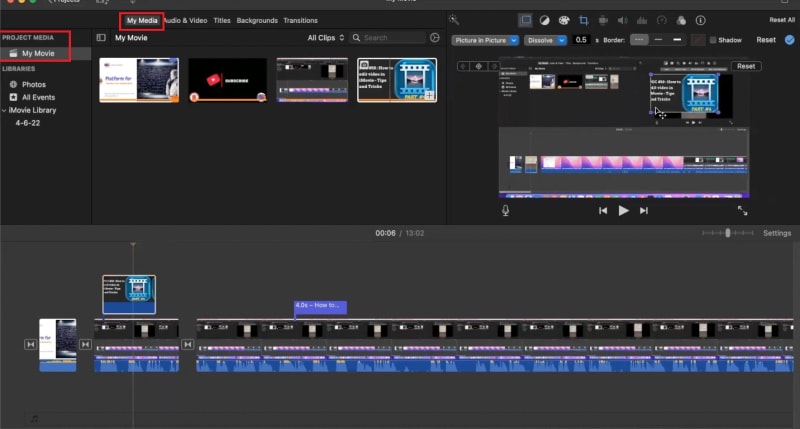
Step 3: Drag and drop the video clips and audio clips on the timeline in proper order. You can go for iMovie edit audio and video such as trimming as required.
Step 4: Go to Transitions located at the top bar beside My Media and place the desired transitions in between the video clips.
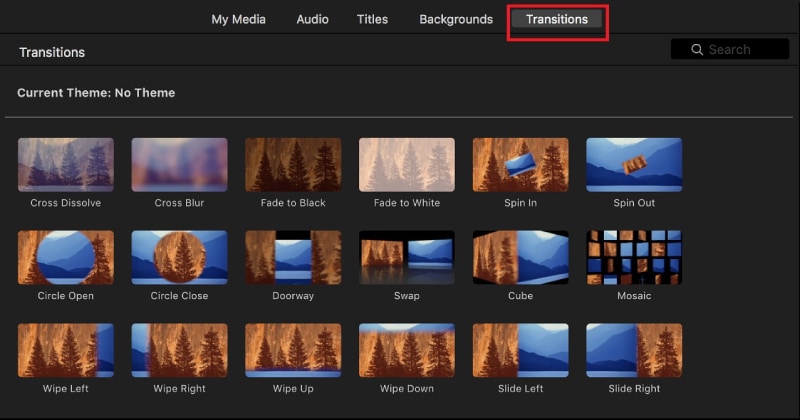
Step 5: Similarly, go to Titles located at the top bar beside Transitions and place them on the timeline wherever appropriate.
Step 6: Finally, check your edited video on the canvas and then go to the top-right corner and click on Export. You will have to option to save it in Theater and share on social media as well as through email and iTunes.

Part 3. Alternative to Edit Videos - Filmora
In spite of iMovie being a good video editor, Mac users search for a better alternative. This is because there are limited transitions and effects available. You can have two video tracks only on the timeline and there is lack of customization. Besides, the advanced features of video editing such as motion tracking are not available. Moreover, there are limited file formats supported for importing and exporting.
Wondershare Filmora is the best alternative to iMovie for Mac users. Filmora is a premium video editor where all the shortcomings of iMovie are taken care of. Filmora supports almost all file formats for media files. There is a wide range of transitions, effects, elements as well as animations available. Besides, there are different styles of texts and titles available along with stock media library. Here are the steps to edit videos with iMovie.
For Win 7 or later (64-bit)
For macOS 10.12 or later
Step 1: Download and install Filmora on your Mac. Launch Filmora and click on New Project.
Step 2: Drag and drop your video clips and audio files Project Media folder. Drag and place the video clips on the timeline and arrange per perfectly. Place audio files on the timeline on a different track.

Step 3: If you want to apply transitions, go to Transitions at the top bar and drag any transition in between video clips on the timeline. You can also insert texts from Titles and objects from Elements from the top bar.
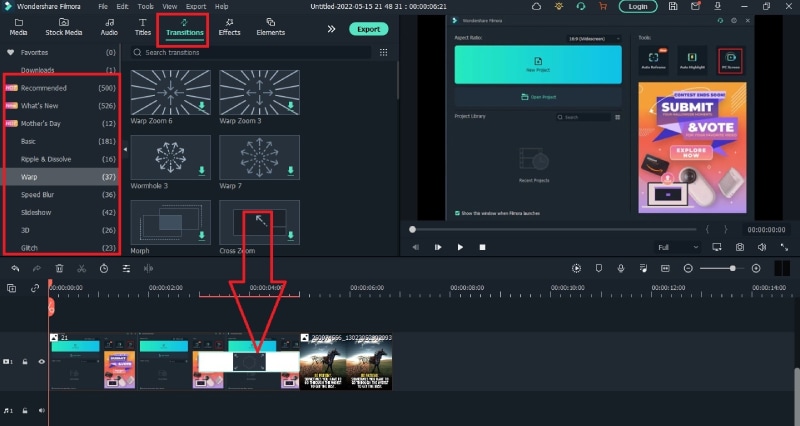
Step 4: Play the video to see the changes you have made, and click on Export button to save the video when you are satisfied.
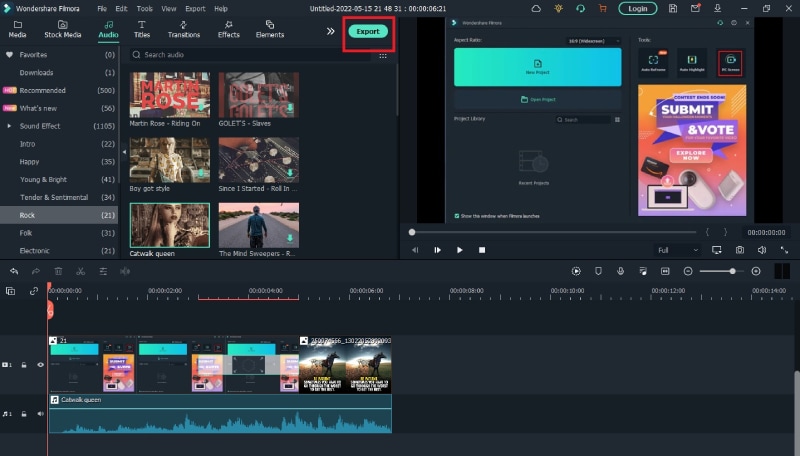
Part 4. FAQs about iMovie
Is iMovie good for video editing?
Yes, iMovie is good for basic video editing. You can edit 4K videos, and iMovie is available on macOS and iOS. If you are a beginner, iMovie is perfect for you. If you want advanced editing features, we recommend Wondershare Filmora.
What’s better Premiere Pro or iMovie?
In terms of features and functionalities, Premiere Pro is far better than iMovie. However, Premiere Pro is more for advanced video editing while iMovie is more for beginners. iMovie is simpler to use than Premiere Pro, and hence, beginners will love it.
Can I make YouTube videos with iMovie?
Yes, you can make YouTube videos with iMovie as it has all the required tools and options. Import your video clips and audio files on the timeline, go for iMovie edit clip like trim and crop as required, add transitions, texts, and effects as applicable and publish your finished video on YouTube.
For macOS 10.12 or later
Step 1: Download and install Filmora on your Mac. Launch Filmora and click on New Project.
Step 2: Drag and drop your video clips and audio files Project Media folder. Drag and place the video clips on the timeline and arrange per perfectly. Place audio files on the timeline on a different track.

Step 3: If you want to apply transitions, go to Transitions at the top bar and drag any transition in between video clips on the timeline. You can also insert texts from Titles and objects from Elements from the top bar.

Step 4: Play the video to see the changes you have made, and click on Export button to save the video when you are satisfied.

Part 4. FAQs about iMovie
Is iMovie good for video editing?
Yes, iMovie is good for basic video editing. You can edit 4K videos, and iMovie is available on macOS and iOS. If you are a beginner, iMovie is perfect for you. If you want advanced editing features, we recommend Wondershare Filmora.
What’s better Premiere Pro or iMovie?
In terms of features and functionalities, Premiere Pro is far better than iMovie. However, Premiere Pro is more for advanced video editing while iMovie is more for beginners. iMovie is simpler to use than Premiere Pro, and hence, beginners will love it.
Can I make YouTube videos with iMovie?
Yes, you can make YouTube videos with iMovie as it has all the required tools and options. Import your video clips and audio files on the timeline, go for iMovie edit clip like trim and crop as required, add transitions, texts, and effects as applicable and publish your finished video on YouTube.
For macOS 10.12 or later
Step 1: Download and install Filmora on your Mac. Launch Filmora and click on New Project.
Step 2: Drag and drop your video clips and audio files Project Media folder. Drag and place the video clips on the timeline and arrange per perfectly. Place audio files on the timeline on a different track.

Step 3: If you want to apply transitions, go to Transitions at the top bar and drag any transition in between video clips on the timeline. You can also insert texts from Titles and objects from Elements from the top bar.

Step 4: Play the video to see the changes you have made, and click on Export button to save the video when you are satisfied.

Part 4. FAQs about iMovie
Is iMovie good for video editing?
Yes, iMovie is good for basic video editing. You can edit 4K videos, and iMovie is available on macOS and iOS. If you are a beginner, iMovie is perfect for you. If you want advanced editing features, we recommend Wondershare Filmora.
What’s better Premiere Pro or iMovie?
In terms of features and functionalities, Premiere Pro is far better than iMovie. However, Premiere Pro is more for advanced video editing while iMovie is more for beginners. iMovie is simpler to use than Premiere Pro, and hence, beginners will love it.
Can I make YouTube videos with iMovie?
Yes, you can make YouTube videos with iMovie as it has all the required tools and options. Import your video clips and audio files on the timeline, go for iMovie edit clip like trim and crop as required, add transitions, texts, and effects as applicable and publish your finished video on YouTube.
For macOS 10.12 or later
Step 1: Download and install Filmora on your Mac. Launch Filmora and click on New Project.
Step 2: Drag and drop your video clips and audio files Project Media folder. Drag and place the video clips on the timeline and arrange per perfectly. Place audio files on the timeline on a different track.

Step 3: If you want to apply transitions, go to Transitions at the top bar and drag any transition in between video clips on the timeline. You can also insert texts from Titles and objects from Elements from the top bar.

Step 4: Play the video to see the changes you have made, and click on Export button to save the video when you are satisfied.

Part 4. FAQs about iMovie
Is iMovie good for video editing?
Yes, iMovie is good for basic video editing. You can edit 4K videos, and iMovie is available on macOS and iOS. If you are a beginner, iMovie is perfect for you. If you want advanced editing features, we recommend Wondershare Filmora.
What’s better Premiere Pro or iMovie?
In terms of features and functionalities, Premiere Pro is far better than iMovie. However, Premiere Pro is more for advanced video editing while iMovie is more for beginners. iMovie is simpler to use than Premiere Pro, and hence, beginners will love it.
Can I make YouTube videos with iMovie?
Yes, you can make YouTube videos with iMovie as it has all the required tools and options. Import your video clips and audio files on the timeline, go for iMovie edit clip like trim and crop as required, add transitions, texts, and effects as applicable and publish your finished video on YouTube.
How to Become a Youtuber?
I’m Sheila and I’m a Youtuber for five years in a row. I’m editing my vlogs using my cellphone only, not until I found this Wondershare Filmora for Personal Computers. Not like any other video editor that you need to crack your brain understanding each and every feature, this video editor that I’m talking about on the other hand, made it simple and very handy to use.

Why I Become a Youtuber
1. How I Decided to Start from Uploading the Video
But before we move forward for more details about the video editor itself, let’s get back first five years ago. It all started when I filmed a certain place during a trip and somebody told me to upload it on YouTube. At first, I was hesitant doing that because I have no clue of what is YouTube. So, I did research and got curious, so I decided to upload the video. Time went by and I started to learn how to vlog.

Uploading the Video
2. The Necessary Things a Vlog Should Have
- A teaser – wherein your aim is to caught the attention of your viewers.
- An intro – what is your channel all about.
- The body of the vlog – the part wherein you’re explaining everything in depth, elaborating things about the topic you chose to share. In this part, you can insert the so called “call of action“ - wherein you can tell your viewers to subscribe, to like and comment something about your vlog you’re tackling. And last is the
- Outro – closing session of your vlog.

Vlog
3. What Have I Encountered on the Way
As the saying goes by, “The beginning is always the hardest part“ and really it was. My YouTube journey was not as easy that even my friends didn’t recognize my endeavors. But still, I continue what I’m doing because I love it. It’s a hobby that at the same time, I’m learning something new on the process. And also, with the help of vlogging, I’m starting to gain my self-esteem that I forgot for many years back.

What Have I Encountered on the Way
It’s not easy to become a Youtuber, because you, yourself is the only one that you’ve got. You are the director – managing everything all at once. The artist (youtuber) - the one who’s going to talk in front of the camera. The scriptwriter – the one who’s in charge of the whole story of the video and even the editor- the one who’ll edit the video afterwards.
On YouTube platform, you have to be consistent. It doesn’t mean that you need to upload a video thrice in a week, but even a video will do. After all, it’s quality over quantity. You’ll have to think what kind of video you’ll upload because you need to give your viewers or audiences something significant out of your vlog. YouTube is the second largest search engine next to Google, so most of the people are searching for answers to their questions. Or even searching solutions to their problems. So, if you have something to offer, why not share it for free.
If you’re a new YouTuber, you don’t need to have high-end equipment’s for vlogging. Anyone can start up by using his/her mobile phone. I used to vlog using my Samsung S-6. Mobile phone nowadays, can record a high-definition resolution. You can add a tripod so that your phone can be sturdy during your filming session. Just film during day time so that you can minimize yourself from buying a ring light. A lavalier microphone can be a useful add-on so that your viewers or audiences can hear your voice clearly.
4. What to Do As a YouTuber
As a Youtuber, you should find your own niche. Something that you’re passionate about. Something denoting products, services, or interests that appeal to a small, specialized section of the population. Something that you’re a hundred percent that you can deliver to them loud and clear.

What to Do As a YouTuber
As a YouTuber, you should be yourself in front of the camera. At first it will be awkward, but in time you’ll get used to it. Speak with your heart and not with your mind because when you start to think of the things that you need to say, you’ll get distracted. But when you speak whatever is in your heart at that very moment, you can create miracles and wonders.
It’s okay that you stutter once in a while. Even a reporter experiencing that kind of phenomena and besides, no one is perfect. Everything that you said unnecessarily can be omitted during the editing process. During editing, the first thing that you need to do is to put all the raw videos in your video editor’s timeline. Cut all the unnecessary part specially the so called, “dead air“ or the part that you’re starting to think and not to talk at all. And your viewers can only see are all dead silence. After that you can add your personal touch. You can add your watermark (your trademark in other words), lower third green screens, subtitle if necessary (the hardest part to be honest) if you’re doing it manually. Some cool stickers, effects and transitions.
5. How I Started Video Editing
As I’ve told you at the start of this article, I’m a phone editor not until I found Wondershare Filmora Video Editor . And I must say that, this video editor is the best video editor for beginners. It has a user-friendly interface that even a person with zero experience on editing can fully understand it’s incredible features easily.
Wondershare Filmora 11 | More Than Just You
It also has new features that I personally not encountered with my previous video editor like Instant Mode and from the word itself, this mode can make your video in a blink of an eye. There’s Creator Academy wherein you can watch very interesting tutorials that can be a big help in your editing skills in the future.
If we’re going to dig in, there are lots of features that’s a game changer when it comes to editing indeed! Like bunch of Title styles that you can choose from. You can insert green screen videos (that I personally love to use in my vlogs) and there’s a Motion Tracker if you want to focus in an object or person in action. If you’re not in the mood in editing manually, you can make a montage and the software will make it for you in the Auto Montage Maker – the software will choose the highlights of your video and deliver the results after.
Key framing is also one of the incredible features of this editor in case that you want to emphasize things in your video. To zoom in/out a certain part to be exact.
How awesome Wondershare Filmora because you don’t need another software. Everything that you need is just right in front of your eyes. When needing of a PC screen recorder, I need another software to use. But as I’ve said this editor have it all. There’s a built in PC screen recorder when you want to do a tutorial video.
Steps to do video editing in Filmora:
Step 1Drag and Drop
The first step is to drag all the raw videos in the timeline.

Drag Raw Videos in the Timeline
Step 2Add Transition
I just found this very cute transition so I put it between the clips.
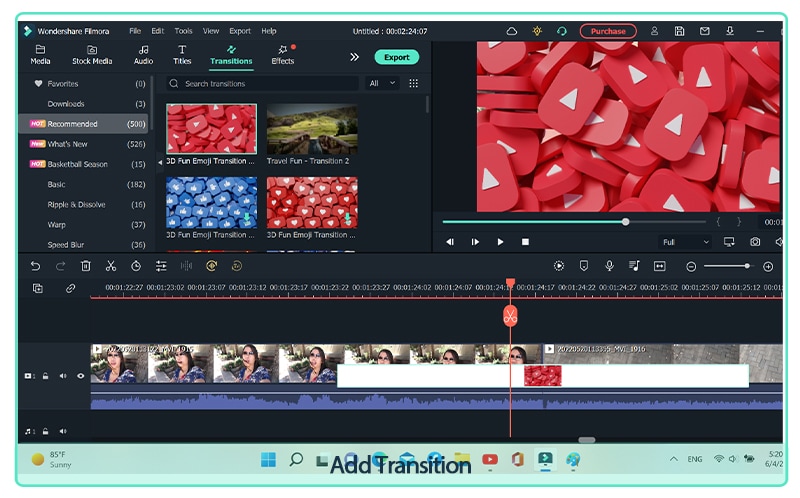
Add Transition
Step 3Lower Third Green
I’m a fan of lower third green so I insert this one.
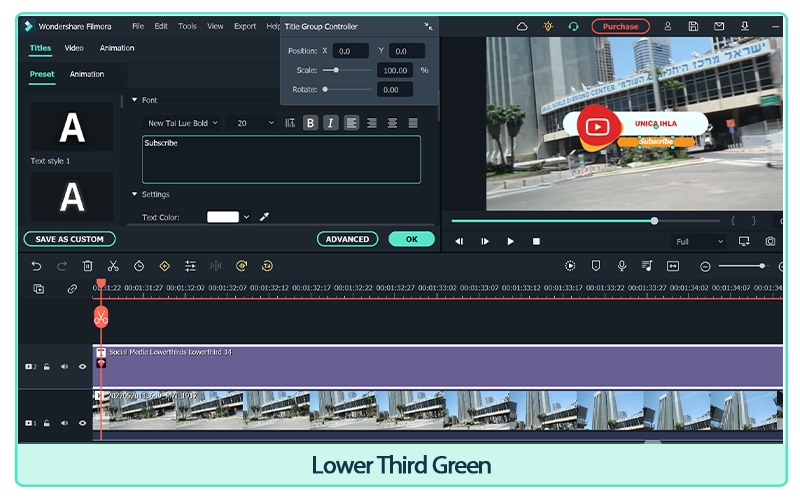
Lower Third Green
Step 4Green Screen
The green screen which I always used in all of my videos, just use the chroma key and the green background will disappear.
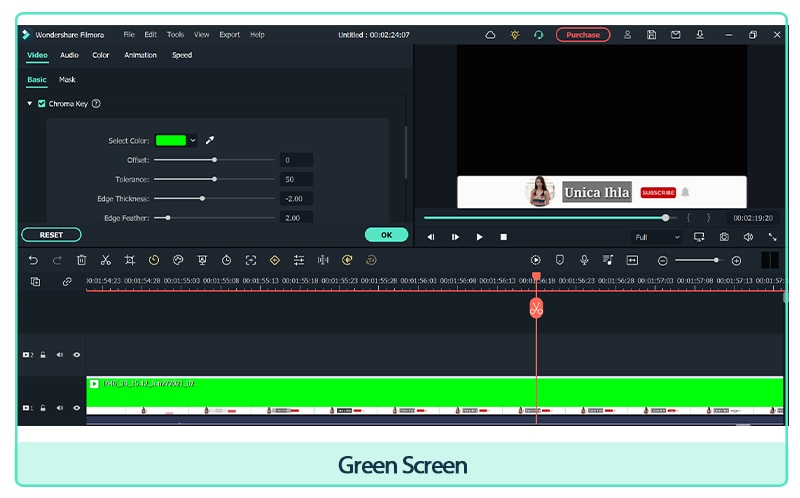
Green Screen
Step 5Varities of End Screens
I found there are varities of end screens so I tried to use this one. Awesome!
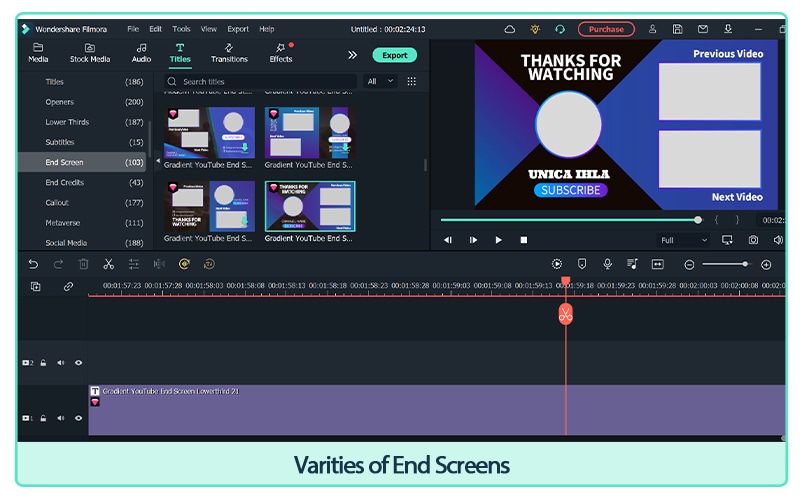
Varities of End Screens
Wrap Up
- To sum it up, if you’re looking for the best video editor for this year 2022; choose Wondershare Filmora and you’ll thank me later. Happy editing!
Wondershare Filmora 11 | More Than Just You
It also has new features that I personally not encountered with my previous video editor like Instant Mode and from the word itself, this mode can make your video in a blink of an eye. There’s Creator Academy wherein you can watch very interesting tutorials that can be a big help in your editing skills in the future.
If we’re going to dig in, there are lots of features that’s a game changer when it comes to editing indeed! Like bunch of Title styles that you can choose from. You can insert green screen videos (that I personally love to use in my vlogs) and there’s a Motion Tracker if you want to focus in an object or person in action. If you’re not in the mood in editing manually, you can make a montage and the software will make it for you in the Auto Montage Maker – the software will choose the highlights of your video and deliver the results after.
Key framing is also one of the incredible features of this editor in case that you want to emphasize things in your video. To zoom in/out a certain part to be exact.
How awesome Wondershare Filmora because you don’t need another software. Everything that you need is just right in front of your eyes. When needing of a PC screen recorder, I need another software to use. But as I’ve said this editor have it all. There’s a built in PC screen recorder when you want to do a tutorial video.
Steps to do video editing in Filmora:
Step 1Drag and Drop
The first step is to drag all the raw videos in the timeline.

Drag Raw Videos in the Timeline
Step 2Add Transition
I just found this very cute transition so I put it between the clips.

Add Transition
Step 3Lower Third Green
I’m a fan of lower third green so I insert this one.

Lower Third Green
Step 4Green Screen
The green screen which I always used in all of my videos, just use the chroma key and the green background will disappear.

Green Screen
Step 5Varities of End Screens
I found there are varities of end screens so I tried to use this one. Awesome!

Varities of End Screens
Wrap Up
- To sum it up, if you’re looking for the best video editor for this year 2022; choose Wondershare Filmora and you’ll thank me later. Happy editing!
How to Make Video Fade to Black in Movie Maker
Windows Movie Maker is a simple video editing tool included with most Windows machines. You can download Movie Maker here if you don’t already have it or want to update to the latest version.
To avoid your video appearing choppy, you should use transitions between segments when creating a movie. A simple and inconspicuous approach is to fade out to a neutral white or black screen.
Fading out a video on a neutral white or black screen is a simple and discreet approach to generating a striking transition between two video clips. You can use the feature to fade out audio files and video files. Adding Fade effects is not difficult; you can find the capabilities in Windows Movie Maker.
With Windows Movie Maker, how do you fade out a video? Though fading out is a beneficial effect for decorating and improving the appearance of your film.
Part 1. In Windows Movie Maker, how to fade to black
When fading out a video on Windows, Windows Movie Maker is a robust and professional option. It offers several capabilities, including the ability to import and create films, as well as the ability to add your photos to create a photo presentation. Additionally, this tool allows you to add effects, titles, and credits while editing. It may also export the altered video into other formats and share it on various social media platforms. It’s vital to note that this software is best suited for beginners with limited editing skills. As a result, advanced editors will find that the capabilities in this package fall short of their expectations. You do not need to download any additional software on Windows if you use Windows Movie Maker to apply a fade-out effect to a video.
Step 1: Locate the section on visual effects.
It is necessary first to download Windows Movie Maker from a reputable website. Then, in the upper portion of the movie maker’s interface, find the “Visual effects” tab. Go to the “Visual effects” section and click the “More” button. After then, the “Available effects” column on the left will appear. You’ve completed approximately half of the steps to fade a video out thus far.
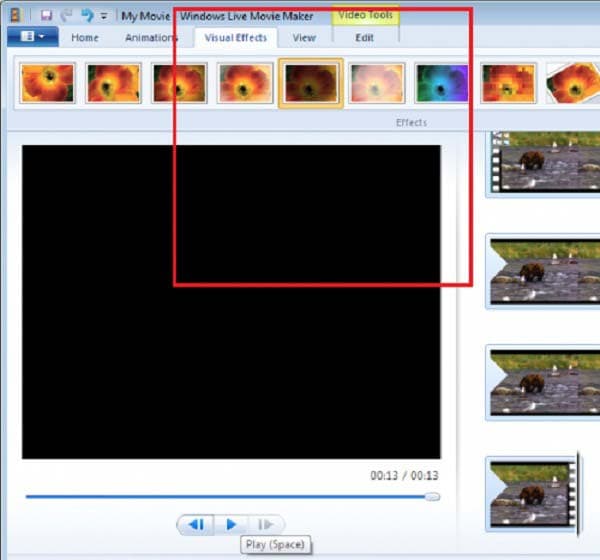
Step 2: For video, add a fade-out effect.
Now that you’ve found the “Available effects,” scroll the slider down until you reach the fade-out selections. To fade out a video with Windows Movie Maker, select the “Fade out” effect and click the “Add” button beneath it. To apply the fade-out effect, remember to click “Apply” afterward. So the “Fade out” effect on the video has been added.

The third step is the wind-up procedure.
Finally, this movie maker allows you to preview the video to check the effects by using the “Play” button to complete the process. All stages have now been completed, and you can save the film to your folder. This software also allows you to post it on social media sites. It’s now your turn to show off your great video, and I hope it’ll be an eye-catching clip that complements your décor. That concludes the entire procedure of fading a video out in Windows Movie Maker.

Part 2. In Windows Movie Maker, how to fade to black
Fade in and out: The “Fade” effects turn a video clip into a black-and-white, sepia, or dreamy image.
Create a “Fade” effect.
- Right-click the video clip in the timeline and choose “Edit/Fading.”
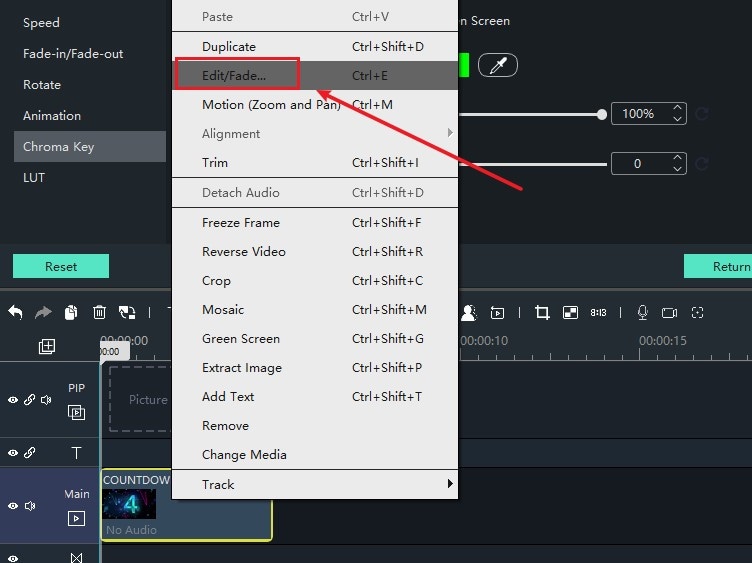
- Drag the slider to set the timing for the Fade in and out.
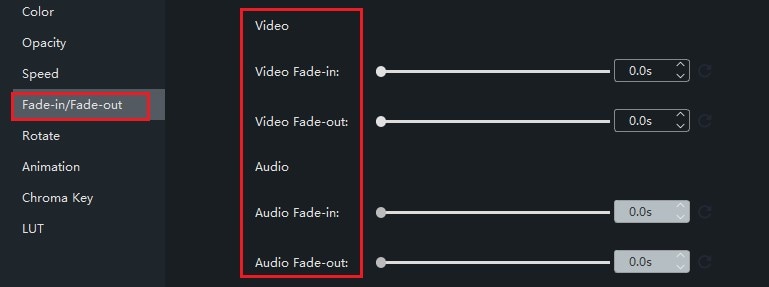
- To confirm, click the “Return” button.
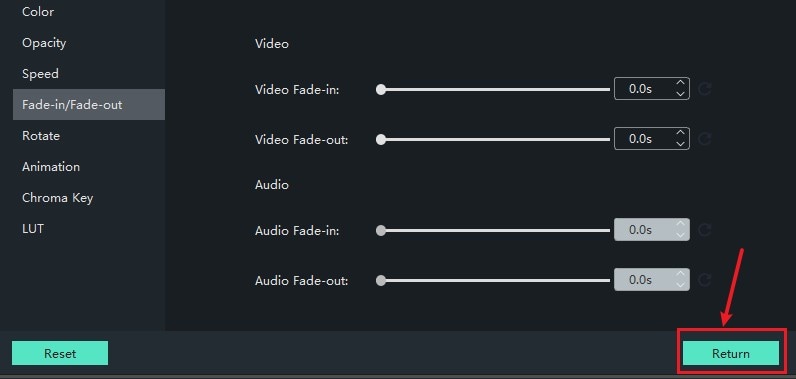
In Filmora, there are several ways to add fade-in and fade-out effects to video.
If you’re using the current version of Filmora, you can fade in and out clips in various ways.
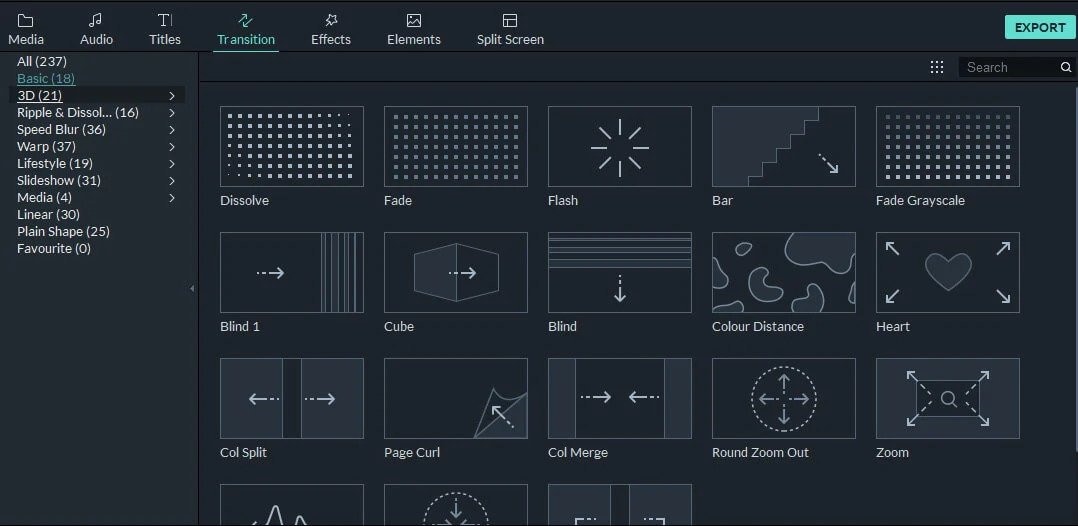
Drag video clips into the timeline after being imported into Filmora.
Under the Basic category on the Transition menu, look for Dissolve. If you didn’t see it, you could use the search bar to find it if you didn’t see it.
Drag the Dissolve transition to the beginning of the footage, then back to the finish of the clip.
How to make video fade to black in movie maker Mac, online, Windows, phone
- iMovie Fade to Black: Desktop
Adding a fade to black transition in iMovie is simple and quick. The following simple guidelines can assist you in adding a fade to black transition at the end of a video. Let’s look at how to make an iMovie fade to black.
Method 1: Finish with a fade to black transition:
Step 1
Select a project. Select “Projects” from the drop-down menu. Drag and drop a video into the editing area after selecting it.
Step 2
Select “Settings.” A drop-down menu will appear after that.
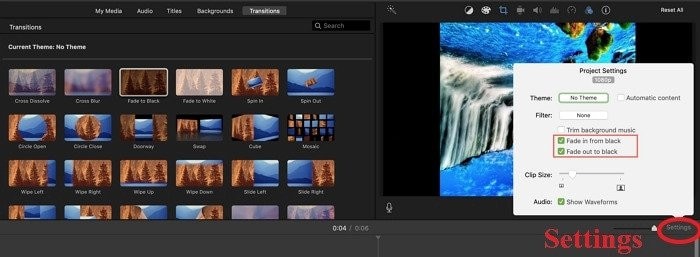
Step 3: Select Fade out to black from the drop-down menu. The video will then fade to black.
- How to Use FlexClip to Fade to Black Online
Most online video editors, aside from iMovie, allow you to apply the Fade to Black transition. FlexClip is one of the highest-rated video creators among them. With this video editor, adding a Fade to Black transition is simple and quick.
It offers a straightforward interface that allows you to add transitions to video in minutes, even if you are new to video editing. Meanwhile, you have access to the great majority of transitions, such as Fade, Wipe, Blur, Zoom, Wrap, and so on. With a few simple clicks, you can simply alter and eliminate the transition.
You can use a variety of resources to enhance your film, including text animation, pre-made intro and outro videos, dazzling effects, royalty-free stock music, and more. Click the button below to get started right away.
Step 1
Add your videos to the media section by uploading them.
Step 2
Wherever you wish the Fade to Black effect to appear, click the “Transitions” button.

Step 3
Choose the Fade to Black option. Select “Fade” and then “Fade to Black.”
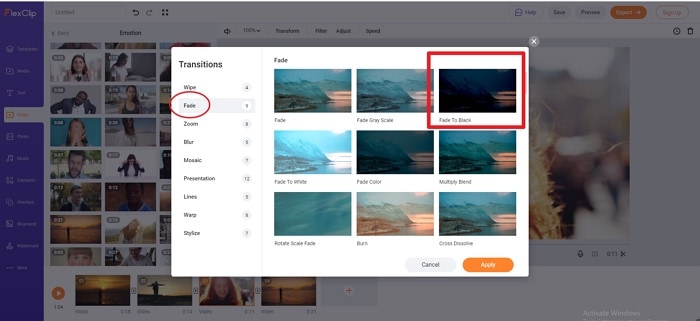
Step 4
Select “Apply” from the drop-down menu. The Fade to Black transition has now been added to the video.
- In iMovie, how do you fade to black? (mobile)
A fade to black effect is simple to implement, similar to the desktop.
Method 1: At the end of a project, fade to black
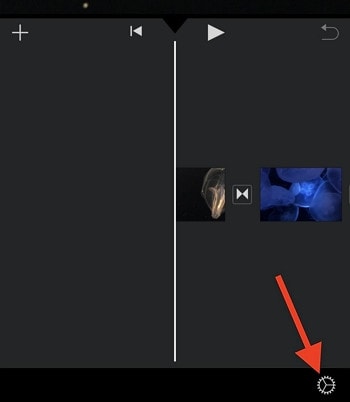
Step 1: Create a new project. Select the videos you require by tapping “Projects” at the top of your screen.
Step 2
Go to the “Settings” menu. At the bottom-right corner of the screen, tap the gear symbol. Then a pop-up menu will appear.
Step 3
Turn on the “Fade out to black” switch.
Step 2: For video, add a fade-out effect.
Now that you’ve found the “Available effects,” scroll the slider down until you reach the fade-out selections. To fade out a video with Windows Movie Maker, select the “Fade out” effect and click the “Add” button beneath it. To apply the fade-out effect, remember to click “Apply” afterward. So the “Fade out” effect on the video has been added.

The third step is the wind-up procedure.
Finally, this movie maker allows you to preview the video to check the effects by using the “Play” button to complete the process. All stages have now been completed, and you can save the film to your folder. This software also allows you to post it on social media sites. It’s now your turn to show off your great video, and I hope it’ll be an eye-catching clip that complements your décor. That concludes the entire procedure of fading a video out in Windows Movie Maker.

Part 2. In Windows Movie Maker, how to fade to black
Fade in and out: The “Fade” effects turn a video clip into a black-and-white, sepia, or dreamy image.
Create a “Fade” effect.
- Right-click the video clip in the timeline and choose “Edit/Fading.”

- Drag the slider to set the timing for the Fade in and out.

- To confirm, click the “Return” button.

In Filmora, there are several ways to add fade-in and fade-out effects to video.
If you’re using the current version of Filmora, you can fade in and out clips in various ways.

Drag video clips into the timeline after being imported into Filmora.
Under the Basic category on the Transition menu, look for Dissolve. If you didn’t see it, you could use the search bar to find it if you didn’t see it.
Drag the Dissolve transition to the beginning of the footage, then back to the finish of the clip.
How to make video fade to black in movie maker Mac, online, Windows, phone
- iMovie Fade to Black: Desktop
Adding a fade to black transition in iMovie is simple and quick. The following simple guidelines can assist you in adding a fade to black transition at the end of a video. Let’s look at how to make an iMovie fade to black.
Method 1: Finish with a fade to black transition:
Step 1
Select a project. Select “Projects” from the drop-down menu. Drag and drop a video into the editing area after selecting it.
Step 2
Select “Settings.” A drop-down menu will appear after that.

Step 3: Select Fade out to black from the drop-down menu. The video will then fade to black.
- How to Use FlexClip to Fade to Black Online
Most online video editors, aside from iMovie, allow you to apply the Fade to Black transition. FlexClip is one of the highest-rated video creators among them. With this video editor, adding a Fade to Black transition is simple and quick.
It offers a straightforward interface that allows you to add transitions to video in minutes, even if you are new to video editing. Meanwhile, you have access to the great majority of transitions, such as Fade, Wipe, Blur, Zoom, Wrap, and so on. With a few simple clicks, you can simply alter and eliminate the transition.
You can use a variety of resources to enhance your film, including text animation, pre-made intro and outro videos, dazzling effects, royalty-free stock music, and more. Click the button below to get started right away.
Step 1
Add your videos to the media section by uploading them.
Step 2
Wherever you wish the Fade to Black effect to appear, click the “Transitions” button.

Step 3
Choose the Fade to Black option. Select “Fade” and then “Fade to Black.”

Step 4
Select “Apply” from the drop-down menu. The Fade to Black transition has now been added to the video.
- In iMovie, how do you fade to black? (mobile)
A fade to black effect is simple to implement, similar to the desktop.
Method 1: At the end of a project, fade to black

Step 1: Create a new project. Select the videos you require by tapping “Projects” at the top of your screen.
Step 2
Go to the “Settings” menu. At the bottom-right corner of the screen, tap the gear symbol. Then a pop-up menu will appear.
Step 3
Turn on the “Fade out to black” switch.
Step 2: For video, add a fade-out effect.
Now that you’ve found the “Available effects,” scroll the slider down until you reach the fade-out selections. To fade out a video with Windows Movie Maker, select the “Fade out” effect and click the “Add” button beneath it. To apply the fade-out effect, remember to click “Apply” afterward. So the “Fade out” effect on the video has been added.

The third step is the wind-up procedure.
Finally, this movie maker allows you to preview the video to check the effects by using the “Play” button to complete the process. All stages have now been completed, and you can save the film to your folder. This software also allows you to post it on social media sites. It’s now your turn to show off your great video, and I hope it’ll be an eye-catching clip that complements your décor. That concludes the entire procedure of fading a video out in Windows Movie Maker.

Part 2. In Windows Movie Maker, how to fade to black
Fade in and out: The “Fade” effects turn a video clip into a black-and-white, sepia, or dreamy image.
Create a “Fade” effect.
- Right-click the video clip in the timeline and choose “Edit/Fading.”

- Drag the slider to set the timing for the Fade in and out.

- To confirm, click the “Return” button.

In Filmora, there are several ways to add fade-in and fade-out effects to video.
If you’re using the current version of Filmora, you can fade in and out clips in various ways.

Drag video clips into the timeline after being imported into Filmora.
Under the Basic category on the Transition menu, look for Dissolve. If you didn’t see it, you could use the search bar to find it if you didn’t see it.
Drag the Dissolve transition to the beginning of the footage, then back to the finish of the clip.
How to make video fade to black in movie maker Mac, online, Windows, phone
- iMovie Fade to Black: Desktop
Adding a fade to black transition in iMovie is simple and quick. The following simple guidelines can assist you in adding a fade to black transition at the end of a video. Let’s look at how to make an iMovie fade to black.
Method 1: Finish with a fade to black transition:
Step 1
Select a project. Select “Projects” from the drop-down menu. Drag and drop a video into the editing area after selecting it.
Step 2
Select “Settings.” A drop-down menu will appear after that.

Step 3: Select Fade out to black from the drop-down menu. The video will then fade to black.
- How to Use FlexClip to Fade to Black Online
Most online video editors, aside from iMovie, allow you to apply the Fade to Black transition. FlexClip is one of the highest-rated video creators among them. With this video editor, adding a Fade to Black transition is simple and quick.
It offers a straightforward interface that allows you to add transitions to video in minutes, even if you are new to video editing. Meanwhile, you have access to the great majority of transitions, such as Fade, Wipe, Blur, Zoom, Wrap, and so on. With a few simple clicks, you can simply alter and eliminate the transition.
You can use a variety of resources to enhance your film, including text animation, pre-made intro and outro videos, dazzling effects, royalty-free stock music, and more. Click the button below to get started right away.
Step 1
Add your videos to the media section by uploading them.
Step 2
Wherever you wish the Fade to Black effect to appear, click the “Transitions” button.

Step 3
Choose the Fade to Black option. Select “Fade” and then “Fade to Black.”

Step 4
Select “Apply” from the drop-down menu. The Fade to Black transition has now been added to the video.
- In iMovie, how do you fade to black? (mobile)
A fade to black effect is simple to implement, similar to the desktop.
Method 1: At the end of a project, fade to black

Step 1: Create a new project. Select the videos you require by tapping “Projects” at the top of your screen.
Step 2
Go to the “Settings” menu. At the bottom-right corner of the screen, tap the gear symbol. Then a pop-up menu will appear.
Step 3
Turn on the “Fade out to black” switch.
Step 2: For video, add a fade-out effect.
Now that you’ve found the “Available effects,” scroll the slider down until you reach the fade-out selections. To fade out a video with Windows Movie Maker, select the “Fade out” effect and click the “Add” button beneath it. To apply the fade-out effect, remember to click “Apply” afterward. So the “Fade out” effect on the video has been added.

The third step is the wind-up procedure.
Finally, this movie maker allows you to preview the video to check the effects by using the “Play” button to complete the process. All stages have now been completed, and you can save the film to your folder. This software also allows you to post it on social media sites. It’s now your turn to show off your great video, and I hope it’ll be an eye-catching clip that complements your décor. That concludes the entire procedure of fading a video out in Windows Movie Maker.

Part 2. In Windows Movie Maker, how to fade to black
Fade in and out: The “Fade” effects turn a video clip into a black-and-white, sepia, or dreamy image.
Create a “Fade” effect.
- Right-click the video clip in the timeline and choose “Edit/Fading.”

- Drag the slider to set the timing for the Fade in and out.

- To confirm, click the “Return” button.

In Filmora, there are several ways to add fade-in and fade-out effects to video.
If you’re using the current version of Filmora, you can fade in and out clips in various ways.

Drag video clips into the timeline after being imported into Filmora.
Under the Basic category on the Transition menu, look for Dissolve. If you didn’t see it, you could use the search bar to find it if you didn’t see it.
Drag the Dissolve transition to the beginning of the footage, then back to the finish of the clip.
How to make video fade to black in movie maker Mac, online, Windows, phone
- iMovie Fade to Black: Desktop
Adding a fade to black transition in iMovie is simple and quick. The following simple guidelines can assist you in adding a fade to black transition at the end of a video. Let’s look at how to make an iMovie fade to black.
Method 1: Finish with a fade to black transition:
Step 1
Select a project. Select “Projects” from the drop-down menu. Drag and drop a video into the editing area after selecting it.
Step 2
Select “Settings.” A drop-down menu will appear after that.

Step 3: Select Fade out to black from the drop-down menu. The video will then fade to black.
- How to Use FlexClip to Fade to Black Online
Most online video editors, aside from iMovie, allow you to apply the Fade to Black transition. FlexClip is one of the highest-rated video creators among them. With this video editor, adding a Fade to Black transition is simple and quick.
It offers a straightforward interface that allows you to add transitions to video in minutes, even if you are new to video editing. Meanwhile, you have access to the great majority of transitions, such as Fade, Wipe, Blur, Zoom, Wrap, and so on. With a few simple clicks, you can simply alter and eliminate the transition.
You can use a variety of resources to enhance your film, including text animation, pre-made intro and outro videos, dazzling effects, royalty-free stock music, and more. Click the button below to get started right away.
Step 1
Add your videos to the media section by uploading them.
Step 2
Wherever you wish the Fade to Black effect to appear, click the “Transitions” button.

Step 3
Choose the Fade to Black option. Select “Fade” and then “Fade to Black.”

Step 4
Select “Apply” from the drop-down menu. The Fade to Black transition has now been added to the video.
- In iMovie, how do you fade to black? (mobile)
A fade to black effect is simple to implement, similar to the desktop.
Method 1: At the end of a project, fade to black

Step 1: Create a new project. Select the videos you require by tapping “Projects” at the top of your screen.
Step 2
Go to the “Settings” menu. At the bottom-right corner of the screen, tap the gear symbol. Then a pop-up menu will appear.
Step 3
Turn on the “Fade out to black” switch.
Also read:
- Updated Top 15 Best Free MP4 Video Rotators Windows, Mac, Android, iPhone & Online for 2024
- Updated 2024 Approved 8 Frame Rate Video Converters You Must Try
- Updated The Right Ways to Slow Down a Video on iPhone for 2024
- Updated 2024 Approved How to Use Twixtor Effect to Create Super Slow-Motion Video?
- How to Create a DIY Green Screen Video Effect for 2024
- 2024 Approved How to Create an Adobe Slideshow the Easy Way
- Updated The Best Cinematic LUTs in The Market
- Updated In 2024, Top Free Video Editing Software Enhance Your Content with These Essential Tools
- 2024 Approved 3D Ray Traced Settings In After Effects
- In 2024, How To Add Scrolling Text Effect
- New Merging MP4 Videos Made Simple Top 5 Online Tools
- 2024 Approved In This Article You Will Learn How to Crop a Video Through Windows Media Player and with Filmora Wondershare. Here Are Ways to Crop Your Video Clip
- Updated 2024 Approved Top Fixes to Resolve Issues with Premiere Pro Slow Playback
- 2024 Approved Wondering How to Replace Sky in After Effects? Learn How
- Updated Adding Slow Motion in DaVinci Resolve A Comprehensive Overview
- How to Cut Videos on Mac without Using FFmpeg?
- Updated Tips That Show Anybody How To Make Youtube Slideshow – Guaranteed for 2024
- Premiere Pro Tutorial How To Change Video Frame Rate
- 2024 Approved Read This Review to Learn Everything You Need to Know About Leeming LUT Pro and How to Apply Pro LUTs Using Different Video Editors
- Top 20 Slideshow Makers for Win/Mac/Online Review
- How to Crop Videos in Windows Media Player for 2024
- In 2024, 12 Impressive AI Video Ideas for Making Engaging Video Content
- 2024 Approved 5 Ways to Denoise a Video
- Updated 2024 Approved How to Create the Night-to-Day Effect Video
- Updated In 2024, Video Maker with Song
- Updated Mask Tracking Is Believed to Be a Helpful Procedure for Marking Proper Areas in Videos. Learn How to Perform Premiere Pro Mask Tracking in This Guide
- New In 2024, 10 Matching Color Combination That Works Together
- Splitting Audio From Video in Sony Vegas Step by Step for 2024
- New In 2024, 2 Easy Methods | How To Zoom In On TikTok Videos?
- New How to Create Cinematic Style Videos? Easy Guide for Beginners
- Updated Finding The Best Filmic Pro LUTs For Video Editing
- New Control Playback Speed in Premiere Pro for 2024
- New How to Add Subtitles to Videos With Kapwing for 2024
- New Best GIF to AVI Converters (Online + Software Solutions)
- New Adobe After Effects Review for 2024
- In 2024, This Article Discusses What Is Hitfilm Express, How to Download, Install and Use It, and Its Key Features. It Further Discusses Its Alternative for Editing Your Videos and More. Check Out Now
- Updated 2024 Approved Guide To Scaling and Setting Videos in Filmora | Tutorial
- Updated In 2024, Phone Aspect Ratio Vertical Definition, Types and Tips
- New Frame Rates, Speed, and Wondershare Filmora for 2024
- Updated Any Video May Be Enhanced Using Adobe Premiere Transitions. If You Are Looking to Learn How to Add Fade to Black in Premiere Pro? Then, Check Out This Fade to Black Transition Premiere Pro Guide to Learn the Trick
- Updated Top 5 Best Video to PPT Converters
- Updated Top 5 Free Online Video Filter Editors Improve Your Videos with Filters for 2024
- 2024 Approved The Power of Music in Videos
- Top 10 Sound Extractors to Extract Sound From Video 2023
- Top 10 Old Film Overlays to Make Your Videos Look Vintage
- How to Intercept Text Messages on Vivo Y77t | Dr.fone
- In 2024, How To Change Your Apple ID on iPhone 13 Pro With or Without Password
- Guide to Mirror Your Vivo Y27 5G to Other Android devices | Dr.fone
- Ways To Find Unlocking Codes For Oppo Reno 9A Phones
- In 2024, How to Remove a Previously Synced Google Account from Your Vivo X Flip
- Thinking About Changing Your Netflix Region Without a VPN On Vivo Y27 5G? | Dr.fone
- Home Button Not Working on Honor 100 Pro? Here Are Real Fixes | Dr.fone
- In 2024, How to Remove Apple ID from iPhone 13 Pro Max without Password?
- How to Unlock Apple iPhone 8 with IMEI Code?
- In 2024, How to fix iCloud lock on your Apple iPhone 11 and iPad
- In 2024, Bypass Activation Lock From Apple iPhone 15 - 4 Easy Ways
- How to Turn Off Find My iPhone 15 Plus when Phone is Broken? | Dr.fone
- How to Change Location On Facebook Dating for your Apple iPhone XS Max | Dr.fone
- How to Unlock Xiaomi Mix Fold 3 Phone without Any Data Loss
- Recover Lost Photos during Transfer from iPhone 6s to PC or Mac | Stellar
- Why Stellar Data Recovery for iPhone 13 Pro takes time in scanning my iPhone? | Stellar
- Pokemon Go Error 12 Failed to Detect Location On Realme 10T 5G? | Dr.fone
- Easy Guide to Infinix Hot 40 FRP Bypass With Best Methods
- 7 Ways to Lock Apps on Apple iPhone 11 and iPad Securely
- Ultimate Guide on Apple iPhone 14 Pro iCloud Activation Lock Bypass
- The Easiest Methods to Hard Reset Realme 12 Pro 5G | Dr.fone
- In 2024, What Legendaries Are In Pokemon Platinum On Realme GT 5 (240W)? | Dr.fone
- In 2024, How to Change GPS Location on Vivo S17t Easily & Safely | Dr.fone
- How to retrieve erased messages from Lava Blaze 2 5G
- How to Unlock Samsung Galaxy M54 5G Phone without Google Account?
- In 2024, How To Change Realme Narzo N55 Lock Screen Password?
- Fix Samsung Galaxy M34 Android System Webview Crash 2024 Issue | Dr.fone
- 7 Solutions to Fix Chrome Crashes or Wont Open on OnePlus Nord CE 3 Lite 5G | Dr.fone
- Ultimate Guide from iPhone 14 Pro Max iCloud Activation Lock Bypass
- Updated 2024 Approved Breaking Language Barriers Elevate Your Content with the Best Free Video Translator Apps
- In 2024, Solutions to Spy on Nokia C110 with and without jailbreak | Dr.fone
- In 2024, Everything You Need To Know About Unlocked iPhone 12 Pro | Dr.fone
- 3 Ways to Unlock iPhone XS without Passcode or Face ID | Dr.fone
- Title: 2 Effective Ways to Make SRT File Translation Like a Pro
- Author: Chloe
- Created at : 2024-05-20 03:37:18
- Updated at : 2024-05-21 03:37:18
- Link: https://ai-editing-video.techidaily.com/2-effective-ways-to-make-srt-file-translation-like-a-pro/
- License: This work is licensed under CC BY-NC-SA 4.0.

